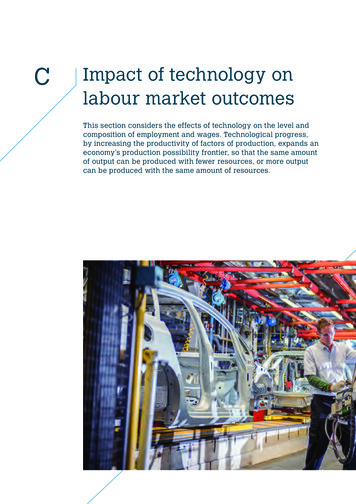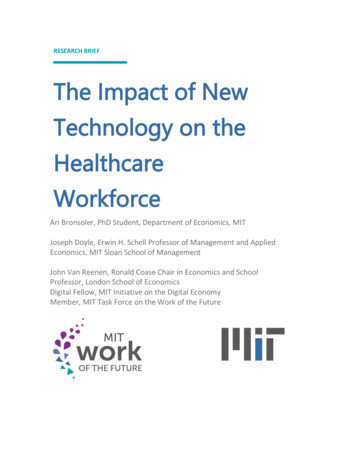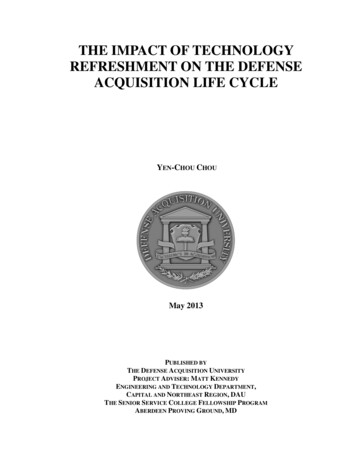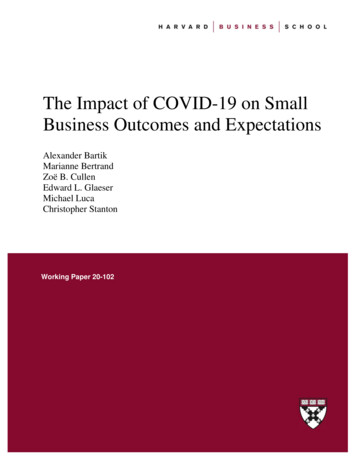
Transcription
CImpact of technology onlabour market outcomesThis section considers the effects of technology on the level andcomposition of employment and wages. Technological progress,by increasing the productivity of factors of production, expands aneconomy’s production possibility frontier, so that the same amountof output can be produced with fewer resources, or more outputcan be produced with the same amount of resources.
Contents1. Introduction762. Overall net employment and wage effects of technology783. T he impact of technology on skills and work tasks834. T echnology and the future of work905. Conclusions99Some key facts and findings Technological progress can assist workers, through labour-augmentingtechnology, or replace them, via automation. In both cases, the overall effectson the market’s demand for labour are ambiguous. Current technological progress has led to a higher relative demand for skilledworkers and a lower relative demand for workers performing routine activities. The use of computers in the workplace has been the central force drivingchanges in the wages of skilled workers relative to the wages of unskilledworkers. Various methodologies have been developed to estimate the share of jobs atrisk from automation and computerization. According to these methodologies,the estimated share of jobs at risk tends to be larger in developing countriesthan in developed countries because of their larger share of employment inroutine occupations. Automation does not necessarily equate with future unemployment becausethe development, adoption and widespread use of future technologies willhinge on a number of factors, including feasibility and affordability, as wellas the legal and regulatory framework in particular countries and publicacceptance of new technology. However, future automation is likely to bedisruptive for workers whose skills will become obsolete and who face the riskof job losses and having to switch tasks and jobs.
WORLD TRADE REPORT 20171.IntroductionTechnology can be broadly defined as "the stateof knowledge concerning ways of convertingresources into outputs" (OECD, 2011a) or as the"machinery and equipment developed from theapplication of scientific knowledge" (Oxford EnglishDictionary). There are two types of processesinvolved in producing a new technology: inventionand innovation. Invention involves the formulation ofscientific principles or processes. Innovation entailsthe direct application of this knowledge to a usefulpurpose in response to presumed profit opportunities.As argued in Section B of this report, innovation cantake the form of new products or a new quality of aproduct (product innovation) or of new productiontechniques (process innovation). New technologiesstemming from innovation have effects on theeconomy, and on society more generally, that areproportional to how widely they are adopted. Generalpurpose technologies (GPTs) – technologies thattransform both household life and the ways in whichfirms conduct business (Jovanovic and Rousseau,2005) – have more widespread effects across firmsand sectors than technologies destined for particularproduction processes or purposes.Technology can complement workers (so-calledlabour-augmenting technology) or substitute for them(so-called labour-saving technology, or automation).If technology complements workers, this implies thatit increases labour productivity. Autopilot technologyon planes or statistical software for data analysis aregood examples of labour-augmenting technologies.Automation technologies, in turn, complete cognitiveor manual tasks without human intervention.1Repetitions (such as executing loops in a programmecode or corking wine bottles in a winery) are goodexamples of automation.Several recent studies show the positive effects ofnew technology on labour productivity. In the valvemanufacturing industries of the United Kingdomand the United States, the adoption of computercontrolled technology resulted in a substantialincrease in productivity by reducing setup time,production time and inspection time (Bartel et al.,2007). Collard-Wexler and De Loecker (2015),who study the US steel industry, show that the(partial) displacement of older technology (verticallyintegrated producers) with a new production process(the minimill) was responsible for over one-third ofthe increase in the industry’s total factor productivity,or 38 per cent in the period 1963 to 2002. Shifts toenergy-efficient technology may increase workers’productivity, such as the move from standardfluorescent lighting to LED lighting in factories, whichimproves working conditions in hot humid climatesin Bangalore (India) due to the lower heat emissionsproduced by LED lighting (Adhvaryu et al., 2016). 2 Inthe services sector, a travel agency in China whichemploys 16,000 workers saw a 13 per cent rise inlabour productivity for home-based workers (Bloom etal., 2015). Box C.1 shows how technological changethat raises labour productivity can be conceptualizedin a production possibility frontier (PPF) framework.Box C.1: Technological change in a production possibility frontier (PPF) frameworkThe production possibility frontier (PPF) of an economy describes the amount of output that can be producedfor given amount of inputs, measured in efficiency units.To see how technological change affects an economy’s PPF, consider the simplest possible case of a twosector economy (х and у), with production in both sectors being subject to diminishing returns to a singlefactor of production: labour. Diminishing returns imply that, in each sector, the marginal productivity of labourdiminishes in the amount of labour employed in that sector. With diminishing returns, the PPF is concave(as plotted in Figure C.1). Another characteristic of production functions giving rise to concave PPFs aredifferent factor intensities across the two sectors (even under constant returns) (see Snyder and Nicholson,2010, pages 416-7).Production functions for the two goods are х and у , where ,i х,у represent the efficiencyunits of labour allocated to each sector (physical units of labour multiplied by a sector-specific technologyparameter Α i ): Α х L х and76 Αу Lу
TRADE , TECHNOLOGY AND JOBSBox C.1: Technological change in a production possibility frontier (PPF) framework (continued)The PPF of this economy is represented by the following quarter circle:у 2 Αу L х 2,whereL L х Lуis the total amount of labour in the economy. This is represented by the solid line in panels (a), (b) and (c)of Figure C.1 (the solid line in panels (a)-(c) of Figure C.1 is drawn assuming Α х Αу 1 and L 100).Technological progress – an increase in Α – causes an outward shift in the PPF. This is due to the fact thatan increase in Α increases the marginal productivity of labour in the sector(s) where it occurs, so that theeconomy can produce more with the same amount of physical units of input (in this case, with the samenumber of workers). Marginal productivity of labour in sector i, i х,у is equal to (. This increasesin Αi and, due to diminishing returns, decreases in Li .(The dashed line in panel (b) is drawn assuming a doubling of productivity only in sector х, Α х 2, and keepingΑу 2 and L 100. Conversely, the dashed line in panel (c) is drawn assuming a doubling of productivity onlyin sector у, Αу 2, and keeping Α х 2 and L 100. Clearly, even if technological change occurred in bothsectors, it would still be biased in favour of one sector if the increase in labour productivity was larger in thatsector than in the other.C. I MPACT OF TECHNOLOGYON LABOUR MARKETOUTCOMESPanels (a)-(c) of Figure C.1 represent three types of technological progress. In panel (a) such progress isneutral, since it increases labour productivity equally in the two sectors. This is referred to as Hicks-neutralor balanced productivity change. This type of technological progress could, for instance, be due to theintroduction of a general-purpose technology (GPT), adopted in all sectors. This is represented by a paralleloutward shift in the PPF from the solid to the dashed line – the dashed line is drawn assuming a doubling ofproductivity in each sector, so that Α х Αу 2, and keeping L 100. In panel (b), technological progress isbiased in favour of sector х: it is assumed that technology improves labour productivity only in х, and not in у.Panel (c) presents the opposite case of technological change biased in favour of sector у.In all cases, technological change causes an outward shift in the PPF, allowing the economy to produce(and consume) more for a given amount of inputs. Note that the equilibrium of the economy (not shown in thefigures) will be at the point of tangency between the PPF and the highest indifference curve representingconsumers' preferences. The new equilibrium could also be reached with international trade. Trade, rather thanshifting the PPF, changes relative prices and allows for a separation between production and consumptiondecisions. In this sense, trade and technology could have the same effects in general equilibrium.Figure C.1: Technological change in a production possibility frontier frameworkOriginal production possibility frontierNew production possibility frontier following technological change1212121010108886Sector y14Sector y14Sector y14664442220002468 10 12 14 16Sector x(a) Neutral technological change002468 10 12 14 16Sector x(b) х - biased technological change02468 10 12 14 16Sector x(c) у - biased technological changeSource: WTO Secretariat.77
WORLD TRADE REPORT 2017The use of computers, information technology(IT) and the internet has effects that go far beyondlabour productivity. Digital trade and internationale-commerce reduce transaction costs and boost thetransparency of markets (Lippoldt and House, 2017).They allow consumers a more convenient and efficientshopping experience, raising living standards beyondreal GDP growth (Hulten and Nakamura, 2017). Moregenerally, the use of information and communicationstechnology (ICT) increases the availability of marketinformation, leading to a better and more stablefunctioning of markets (consider improved jobmatches in the labour market due to more readilyavailable information on wages, job vacancies, skillrequirements, and labour market conditions).The effects of labour-augmenting and labourreplacing technologies on labour demand areambiguous. An example is the introduction oftechnologies in agriculture. The related increasesin agricultural labour productivity can be correlatedwith a reduction in agricultural employment if, as aresult of falling relative prices of agricultural goods,economy-wide prosperity increases and householddemand for agricultural produce grows less thandemand for other goods. Automation, in turn, isintrinsically labour-saving, as it reduces labourrequirements per unit of output produced. However,even labour-saving technology can be associatedwith rising labour demand due to lower productioncosts. The first part of this section reviews themechanisms that give rise to the ambiguous effectsof technology on employment, and discusses theirempirical relevance.By making some products or production processesobsolete, and by creating new products or expandingdemand for products that are continuously innovated,technological change is necessarily associated withthe reallocation of labour across and within sectorsand firms. Such technology-induced reallocationsaffect workers differently, depending on their skills oron the tasks they perform. ICTs tend to be used moreintensively and more productively by skilled workersthan by unskilled workers. Automation tends to affectroutine activities more than non-routine activities,because machines still do not perform as well ashumans when it comes to dexterity or communicationskills. In Section C.3, evidence is presented in favourof the hypothesis that the labour market effects oftechnology are relatively more favourable to skilledworkers and to workers performing tasks that areharder to automate.78Advances in smart technology, artificial intelligence,robotics and algorithms, often referred to as thefourth industrial revolution, are taking place atunprecedented pace. Graetz and Michaels (2015)report that from 1993 to 2007, mean robot densityincreased by more than 150 per cent in 17 industrialcountries. Boston Consulting Group (2017) reportsthat the number of industrial robots in operation couldincrease from the current figure of between 1.5 and1.75 million to between 4 and 6 million by 2025.These significant increases in automation, and thepotentially even wider use of robots in non-industrialsectors, have sparked a debate on the future of work,in particular on whether the demand for human labourmight decrease permanently, leading to a “joblessfuture” characterized by artificial intelligence androbotics at a massive scale. Section C.4 reviews theevidence on the pace of technology adoption and thearguments of technology optimists and pessimistsregarding the future of work. The section alsodiscusses the implications for skills development.2.Overall net employment andwage effects of technologyThroughout history, technological change has oftenbeen a source of anxiety for many workers. In Englandbetween 1811 and 1816, a group of workers whocalled themselves “Luddites” destroyed machinerywhich they believed was threatening their jobs,especially in cotton and woollen mills. Nineteenthcentury economists like Karl Marx and David Ricardopredicted that the mechanization of the economywould worsen conditions for workers, ultimatelycondemning them to live on a subsistence wage. Inthe last century, too, prominent economists like JohnM. Keynes (in the 1930s) and Wassily Leontief (inthe 1950s) expressed the fear that more and moreworkers would be replaced by machines, and thatthis would lead to technological unemployment. 3More recently, Brynjolfsson and McAfee (2014) haveclaimed that such disruptive technologies reduce thedemand for labour and put workers at a permanentdisadvantage.This section discusses the mechanisms behind therelationship between technological change andoverall employment, and the empirical evidencerelated to those mechanisms.(a)Theoretical mechanismsAs famously shown by Baumol (1967), technologicallyadvancing sectors – that is, those experiencing morerapid productivity growth – tend to contract as a shareof employment, while technologically lagging sectors– that is, those with slow productivity growth – tendto expand. This is because technological progressreduces labour requirements per unit of output
TRADE , TECHNOLOGY AND JOBSproduced. Figure C.2 plots indexes of manufacturingemployment (as a share of total employment) andlabour productivity (output per employed personin manufacturing) between 1970 and 2011 for twomajor industrial countries (Germany and the UnitedStates). During the six decades covered by thedata, manufacturing employment as a share of totalemployment fell substantially, but manufacturinglabour productivity increased. 4Labour-saving technologies, however, are not onlydeployable in the primary and secondary sectors. Theintroduction of earth-moving equipment and poweredtools displaced manual labour from the constructionsector, for instance (Autor, 2015). Occupations suchas telegraph or elevator operators, which figured in the1950 US Census, have been eliminated altogether,due to technological obsolescence in the case ofthe former and to automation of the latter (Bessen,2017). 8 Thanks to advances in ICT, the automation oflogistics and processing and of self-service (e.g. indocument creation and management, which no longerrequire clerical support, or in retail self-checkout)and digitization (e.g. of data entry and of publishing/printing) are all services sector activities wherelabour-saving technologies can be deployed and cansubstitute for workers (see World Bank, 2016).C. I MPACT OF TECHNOLOGYON LABOUR MARKETOUTCOMESThese trends can be correlated with the evolutionof one particular type of automation, namely theuse of industrial robots, since the mid-1990s. 5Between 1993 and 1997, robot density (definedas the number of robots per million hours worked)increased by 160 per cent in Germany and by 236per cent in the United States.6 Therefore, increasingautomation is broadly correlated with lower labourrequirements per unit of output in manufacturingadopting such labour-saving technologies. Graetzand Michaels (2015) estimate that, in their sample of14 industries in 17 countries from 1993-2007, robotdensification increased labour productivity by about0.37 percentage points. According to the authors,this figure is fairly comparable to the estimated totalcontribution of steam technology to British annuallabour productivity growth, which was around 0.35percentage points, but was sustained over a periodthat was about four times longer, from 1850 to 1910(Crafts, 2004, cited in Graetz and Michaels, 2015).The deployment of labour-saving technologies is nota recent phenomenon. Without going back as far asthe Industrial Revolution of the late eighteenth andearly nineteenth centuries, one could mention thespectacular decrease in the share of agriculturalemployment in developed countries during the lastcentury. Autor (2015), for instance, reports that in1900, 41 per cent of the US workforce was employedin agriculture; by 2000, that share had fallen to 2 percent, mostly due to a wide range of technologiesincluding automated machinery, such as fieldmachinery and irrigation systems.7Figure C.2: Evolution of employment and output per worker in manufacturing of selectedindustrial countries (1970 to 2011)GermanyUnited States1401804016035140300Employment shareEmployment share ur productivity index25Employment share (percentage)Labour productivity index12045Labour productivity indexSource: US Department of Labor Bureau of Labor Statistics (BLS) International Labor Comparisons (ILC) data.Notes: Labour productivity measured as output per employed person (index, 2002 100 and percentage).79
WORLD TRADE REPORT 2017A simple conceptual framework to understand theeffects of the deployment of new technologies onoverall labour demand is based on the balancebetween substitution and compensation mechanisms(Vivarelli, 2015). It is argued in Section B that iftechnological change takes the form of a new productthat is substituted for an older one, technologicalinnovation lowers the demand for the old productwhile it raises the demand for the new product.This translates into an upward shift in the demandfor labour used to produce the old product and adownward shift in the demand for the workers whoproduce the new products. In other words, thesubstitution mechanism at work operates via productdisplacement. While the resulting adjustment (withsome jobs being destroyed and others being created)may not be without frictions, in this context it is worthnoting that higher labour demand in the growingsector can partially or fully offset lower labour demandin the declining sector, a compensation mechanismthat can produce ambiguous effects on overall labourdemand. 9In the case of labour-replacing automation (analysedin Section B as a reduction in the price of capital),technological change induces firms to adopt morecapital-intensive technologies and to substitute labourfor capital, lowering labour demand at any given wagerate (substitution effect). There are, however, severalcompensation mechanisms that can counterbalancethe initial labour-saving impact of automation, and ofprocess innovation in general (Vivarelli, 2015). First,while workers are displaced in those industries thatintroduce the technology incorporated in the newmachinery, additional workers are needed in theindustries that produce the new machinery.Second, automation (and process innovation moregenerally) reduces average costs. Acemoglu andRestrepo (2017) show that this leads: i) to a priceproductivity effect (as the cost of production goesdown, the industry can expand and increase itslabour demand); and ii) to a scale-productivity effect(the reduction in costs due to automation results inan expansion of total output, raising the demand forlabour in all industries). Similarly, Vivarelli (2015)argues that lower average costs can either translateinto lower prices (if the industry market structure isperfectly competitive), stimulating product demand,or into extra profits (if the industry structure is notperfectly competitive). If these extra profits arere-invested in the firm, this investment can create newjobs.80A third compensating effect potentially leadingto higher labour demand relates to local demandspillovers. Gregory et al. (2016), who study labour-saving technology in the form of routine-biasedtechnological change (see Section C.3), argue thattechnological change creates high-tech jobs whichgenerate additional demand in non-tradable sectors.10One could cite as an example the ICT sector, whichincludes manufacturing sectors, e.g. office machinery,and services sectors, e.g. telecommunications.11In terms of employment, the ICT sector is small,with ICT occupations accounting for 1 per cent ofemployment in developing countries, and 2 to 5 percent in Organisation for Economic Co-operationand Development (OECD) countries (World Bank,2016).12 Moreover, the ICT sector only accounts for aminimal proportion of employment creation, becauseit is by definition capital-intensive.13 For each jobcreated by the high-tech industry, however, aroundfive additional, complementary jobs are created in thelocal economy, mostly in the non-tradable servicessector (Moretti, 2010; Moretti and Thulin, 2013; Gooset al., 2015).Fourth, and most importantly, one should consider thattechnology adoption by firms is a decision affected byvarious factors, including changes in relative prices ofproduction factors.14 In the theoretical framework ofAcemoglu and Restrepo (2016), as a factor becomescheaper, the range of tasks allocated to it expandsand also generates incentives for direct technologiesthat utilize this factor more intensively.15 This impliesthat by reducing the effective cost of producing withlabour, automation discourages further automationand generates a self-correcting force towardsstability in the long run. Thus, it is possible that rapidautomation need not disrupt labour, but might simplybe a transitioning phase towards new technologiesbenefiting labour.16The extent to which the compensation mechanismsdescribed above can counterbalance the laboursaving impacts of technological change depends onseveral underlying assumptions and conditions.17In this context, it is sufficient to point out that thequestion of whether technological change increasesor decreases overall employment and wages is,ultimately, an empirical one, which will be analysed inthe next subsection.(b)Empirical evidenceSo far, the concerns expressed by prominentnineteenth- and twentieth-century economistslike Marx, Ricardo, Keyes and Leontief, that thereplacement of workers by machines would lead totechnological unemployment, have not materialized.Although some individuals may have lost their jobspermanently, the past two centuries of technologicalprogress have not made human labour obsolete.
TRADE , TECHNOLOGY AND JOBSThe employment-to-population ratio rose during the20 th century, and there is no apparent long-runincrease in the unemployment rate (Autor, 2015).Case study evidence focusing on particularsectors and occupations shows that, even afterthe introduction of labour-replacing technologies,employment increased when those technologicalchanges led to significant scale effects.Bessen (2015) reports the telling examples of19 th -century cloth weaving and 20 th -century cashhandling. During the 19 th century, 98 per cent ofthe labour required to weave a yard of cloth wasautomated. However, the number of weaving jobsactually increased. Automation drove the price ofcloth down, increasing the (highly elastic) demand forcloth, resulting in net job growth despite the laboursaving technology (Bessen, 2015).There is abundant econometric evidence on theoverall employment effects of technological change.The studies in this field can be classified accordingto the type of technological change considered (i.e.product innovation, process innovation, routine-biasedtechnological change,18 computerization or exposureto industrial robots), the income level of an economy(developed or developing) and the unit of analysis(firm, industry or local labour markets). The generalconclusion from this literature is that technology hasaffected the structure of employment, but has hadsmall (and mostly positive) effects on the overall levelof employment (Vivarelli, 2014; Arntz et al., 2016b).A positive link between technology and employmentis especially evident when research and development(R&D) and/or product innovation are adopted asproxies of technological change, as well as when thefocus turns to high-tech sectors (Bogliacino et al.,2012). There are, however, a few relevant exceptions,with studies showing negative labour-demand effectsof technological change.C. I MPACT OF TECHNOLOGYON LABOUR MARKETOUTCOMESIn the United States, ATMs (i.e. automatic tellermachines) were introduced in the 1970s, and theirnumber rose fourfold (from 100,000 to 400,000)between 1995 and 2010. ATMs took over cashhandling tasks, yet since 2000 the number offull-time equivalent bank tellers has increased by2 per cent per year, substantially faster than theoverall US labour force (see Figure C.3). Employmentdid not fall because ATMs allowed banks to operatebranch offices at lower costs. This prompted banks toopen many more branches, offsetting the loss in tellerjobs (Bessen, 2015).Figure C.3: ATMs and full-time equivalent bank tellers in the United States (1970 to 2010)500Tellers, ATMs (1,000s) in the United States4003002001000197019801990Full-time equivalent workers20002010ATMsSource: Bessen (2015).81
WORLD TRADE REPORT 2017At the country and industry levels, in a sample of32 industries in 19 developed economies between1970 and 2007, Autor and Salomons (2017) findthat productivity growth has been employmentaugmenting rather than employment-reducing. Inparticular, the fall in industry-level employment asindustry productivity rises (in line with Baumol,1967) is more than offset by the rise in country-levelemployment as aggregate productivity rises. Thisindicates that productivity growth in each sectorgenerates employment growth spillovers elsewherein the economy. These spillovers are sufficiently largeto more than offset employment losses in industriesmaking rapid productivity gains.In a similar vein, Bessen (2017) finds that between1984 and 2007, computer use had a significantnegative effect on manufacturing employment inthe United States, but a mild positive employmenteffect on other industries. Ebenstein et al. (2015),conversely, argue that greater use of computersand capital equipment is associated with loweremployment, higher unemployment and lower labourforce participation across all US occupations. Graetzand Michaels (2015), using International Federationof Robotics (2012) data, estimate that across 17countries over the period 1993-2007, while increasedutilization of robots (robot densification) in a rangeof different industries – particularly in transportequipment, chemicals and metal industries – affectedthe composition of employment and wages acrossskill groups (see Section C.3), there were no adverseaggregate employment effects (i.e. no reductionin aggregate hours worked) of robot densification.Moreover, they estimate the positive and statisticallysignificant effects of robot densification on meanwages. This implies that some of the productivitygains from robot densification were shared withworkers (Graetz and Michaels, 2015).82Some recent studies consider the effects oftechnological change on local labour markets. In astudy using commuting zones in the United States asunits of analysis, Autor et al. (2015) find that exposureto routine task specialization had largely neutraloverall employment effects between 1980 and 2007,only affecting the occupational composition withinsectors. Acemoglu and Restrepo (2017) consider howexposure to industrial robots affected employmentand wages in local labour markets between 1990 and2007, and they estimate large and robust negativeeffects of robots on employment and wages acrosscommuting zones. They suggest that an additionalrobot per thousand workers reduces employmentto population ratio by about 0.18-0.34 percentagepoints (one more robot being associated with areduction in relative commuting zone employmentof 5.6 workers in their favourite specification) andwages by 0.25-0.5.19Conversely, in a study focusing on 238 regionsacross 27 European countries over the 1999-2010period, Gregory et al. (2016) find that routinereplacing technological change led to overall positivelabour demand effects. In terms of the mechanismsthey propose and that were discussed above, thissuggests that the labour demand and the localdemand spillover effects dominated the substitutioneffect. The authors argue that the net effect of routinereplacing technological change on labour demandwas an increase of between 1.9 and 11.6 million jobsacross Europe, depending on whether non-wageincome (returns from technology investments) fedback into the local economy in terms of consumptionor whether it was spent abroad. 20At the firm level, several studies contrast the effectsof product innovation and of process innovation,finding negative employment effects of processinnovation, which tend to be compensated by positiveemployment effects of product innovation. Usingdata on firms in the manufacturing and servicessectors in France, Germany, Spain and the UnitedKin
The use of computers, information technology (IT) and the internet has effects that go far beyond labour productivity. Digital trade and international e-commerce reduce transaction costs and boost the transparency of markets (Lippoldt and House, 2017).











